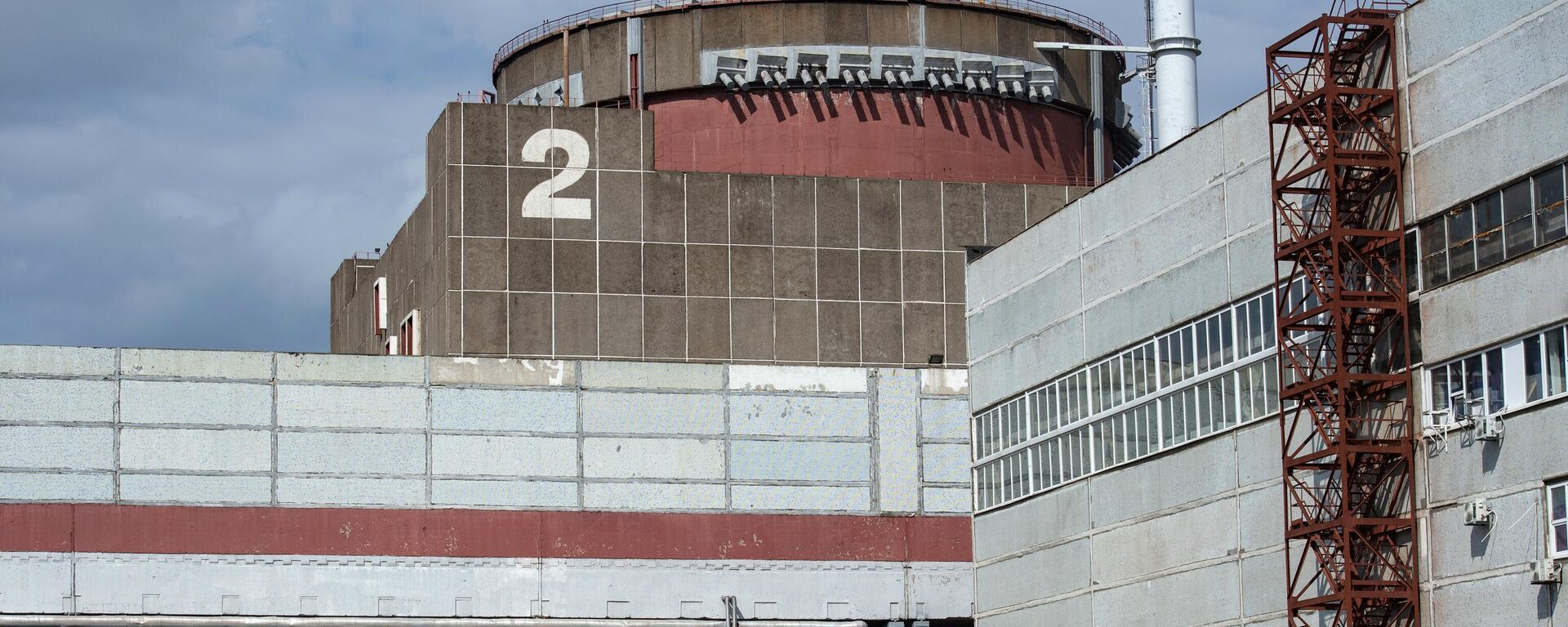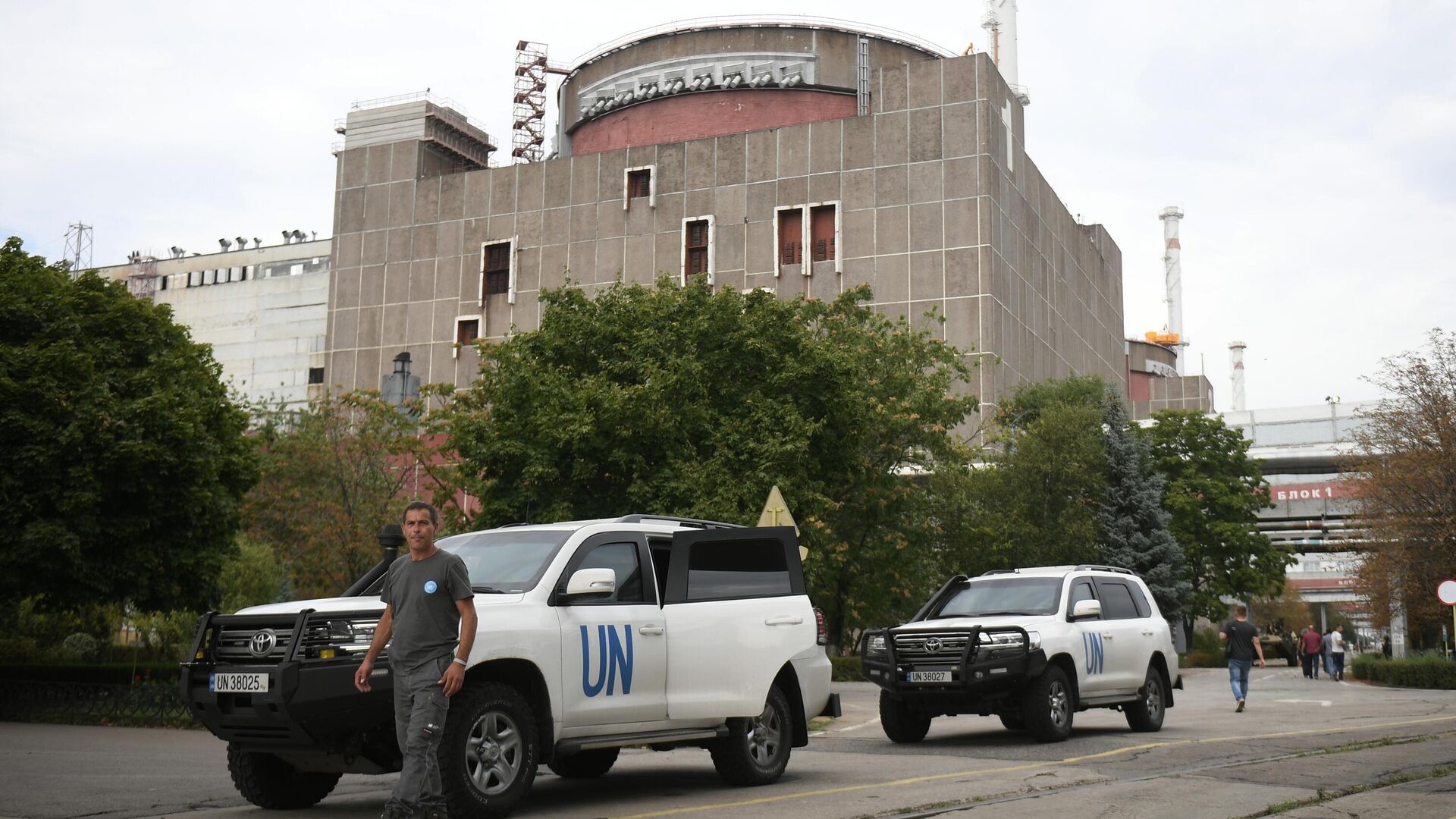https://sputnikglobe.com/20220906/iaeas-report-on-zaporozhye-npp-mission-released-1100449583.html
IAEA Report on Zaporozhye NPP Mentions Mysterious Shelling 52 Times, Doesn’t Name Culprits
IAEA Report on Zaporozhye NPP Mentions Mysterious Shelling 52 Times, Doesn’t Name Culprits
Sputnik International
The United Nations nuclear energy watchdog sent a high-level delegation of experts to the massive nuclear power plant last week. Moscow accused Kiev of trying... 06.09.2022, Sputnik International
2022-09-06T14:22+0000
2022-09-06T14:22+0000
2023-07-31T16:57+0000
russia's special operation in ukraine
iaea
report
zaporozhye
nuclear power plant
https://cdn1.img.sputnikglobe.com/img/07e6/09/06/1100452164_0:176:3017:1873_1920x0_80_0_0_093d8dbecf048c36ad0cee0ab5a95144.jpg
The International Atomic Energy Agency (IAEA) has released a much-anticipated report on the security situation at Ukraine's nuclear facilities.The 52-page document summarizes "preliminary nuclear safety and security findings" from last week's expert mission to the Zaporozhye Nuclear Power Plant and missions to the Chernobyl NPP from earlier this year, and provides an update on the country's other nuclear plants.The report outlines "seven pillars" for nuclear safety, including the need to maintain the physical integrity of nuclear facilities, the continued functioning of safety and security systems at all times, the fulfillment of safety and security duties by nuclear plant staff, reliable off-site power supply from the grid in case of an emergency, reliable logistics and transport supply chains, radiation monitoring, and "reliable communications with the regulator."Mysterious ShellingThe report contains a Ukraine-biased approach in discussing the "physical integrity" of the country's nuclear facilities, particularly as concerns the Zaporozhye plant, citing "Ukrainian reports" on the alleged deployment of Russian military equipment at the ZNPP, and dangers said to arise from Russian cruise missiles flying overhead.The document expresses the IAEA's "concern" with the impact that shelling may have had on "safety-related structures, systems and components," and, citing agency director Rafael Grossi's remarks following his return from last Thursday's inspection, stresses "that while past events had not yet triggered a nuclear emergency, they represented a constant threat to nuclear safety and security because critical safety functions (containment of the radioactivity and cooling in particular) could be impacted."The IAEA's recommendation to ensure the continued physical integrity of the ZNPP is as follows:The report also mentions the presence of Rosatom specialists at the ZNPP, saying that the IAEA fears that their involvement "could lead to interference with the normal lines of operational command or authority and create potential frictions when it comes to decision-making." The document at least admits that the plant's regular management and staff continue to work as normal, but cites anxieties and pressures they have faced, including from shelling incidents (the culprit of the shelling is again not named), as well as problems stemming from staff shortages.Additionally, the document provides a summary of the IAEA's findings from their April visit to the defunct Chernobyl NPP, mentioning "extremely stressful and tiring conditions" experienced by staff during spring, particularly after the loss of regular offsite power and the turn to reliance on emergency diesel generators while the plant was under Russian control. The document does not attribute responsibility for the attacks on the plant's external power sources. The Russian military said Ukrainian forces were responsible. Russian troops withdrew from Chernobyl at the end of March in a bid to calm the situation.The watchdog's report concludes with a congratulatory self-pat on the back, boasting that "despite the very challenging current circumstances, the IAEA has continued to implement safeguards in Ukraine."The ZNPP is the largest nuclear power plant in Europe, and ordinarily accounts for nearly half of all electricity generated by Ukraine's nuclear power plants, and 20 percent of the country's annual power production. The Russian military has held the facility and its six reactors since March, and and Moscow and local authorities have repeatedly accused the Ukrainian military of attacking the plant throughout the past five-and-a-half months and threatening to spark a nuclear catastrophe.The ZNPP was built by the Soviets in the late 1980s, and has faced several emergency nuclear close calls over the past decade in the aftermath of the 2014 Euromaidan coup. In 2014, a technical fault caused one of the plant's reactors to shut down, contributing to rolling blackouts faced across the country that year and in early 2015. In 2020, Ukrainian nuclear industry workers sounded the alarm about the situation across their sector, warning of the dangers of "another Chernobyl" caused by lax safety standards, a critical shortage of finances, incompetent management, and the switchover to the use of American-made nuclear fuel rods.
https://sputnikglobe.com/20220904/russian-mod-journalists-witnessed-ukrainian-saboteurs-failed-storming-of-zaporozhye-npp-1100359547.html
https://sputnikglobe.com/20220829/chernobyl-fukushima-scenario-possible-at-zaporozhye-npp-amid-ukraines-shelling---authorities-1100096675.html
https://sputnikglobe.com/20200410/ukrainian-nuclear-industry-workers-sound-alarm-about-threat-of-another-chernobyl-1078906091.html
zaporozhye
Sputnik International
feedback@sputniknews.com
+74956456601
MIA „Rosiya Segodnya“
2022
News
en_EN
Sputnik International
feedback@sputniknews.com
+74956456601
MIA „Rosiya Segodnya“
Sputnik International
feedback@sputniknews.com
+74956456601
MIA „Rosiya Segodnya“
iaea, report, zaporozhye, nuclear power plant
iaea, report, zaporozhye, nuclear power plant
IAEA Report on Zaporozhye NPP Mentions Mysterious Shelling 52 Times, Doesn’t Name Culprits
14:22 GMT 06.09.2022 (Updated: 16:57 GMT 31.07.2023) The United Nations nuclear energy watchdog sent a high-level delegation of experts to the massive nuclear power plant last week. Moscow accused Kiev of trying to sabotage the mission via a botched offensive, and of engaging in "nuclear terrorism" by repeatedly attacking and shelling the facility with mortars, drones, and artillery.
The International Atomic Energy Agency (IAEA) has released a much-anticipated
report on the security situation at Ukraine's nuclear facilities.
The 52-page document summarizes "preliminary nuclear safety and security findings" from last week's expert mission to the Zaporozhye Nuclear Power Plant and missions to the Chernobyl NPP from earlier this year, and provides an update on the country's other nuclear plants.
The report outlines "seven pillars" for nuclear safety, including the need to maintain the physical integrity of nuclear facilities, the continued functioning of safety and security systems at all times, the fulfillment of safety and security duties by nuclear plant staff, reliable off-site power supply from the grid in case of an emergency, reliable logistics and transport supply chains, radiation monitoring, and "reliable communications with the regulator."
The report contains a Ukraine-biased approach in discussing the "physical integrity" of the country's nuclear facilities, particularly as concerns the Zaporozhye plant, citing "Ukrainian reports" on the alleged deployment of Russian military equipment at the ZNPP, and dangers said to arise from Russian cruise missiles flying overhead.
The report mentions shelling attacks on the ZNPP 52 times, but does not say who is responsible (Ukrainian and Western media have previously reported that the plant was being shelled by Russian forces - the same Russian forces which have controlled the facility since March. Russia has blamed the Ukrainian military).

4 September 2022, 12:49 GMT
The document expresses the IAEA's "concern" with the impact that shelling may have had on "safety-related structures, systems and components," and, citing agency director Rafael Grossi's remarks following his return from last Thursday's inspection, stresses "that while past events had not yet triggered a nuclear emergency, they represented a constant threat to nuclear safety and security because critical safety functions (containment of the radioactivity and cooling in particular) could be impacted."
The IAEA's recommendation to ensure the continued physical integrity of the ZNPP is as follows:
"The IAEA recommends that shelling on site and in its vicinity should be stopped immediately to avoid any further damages to the plant and associated facilities, for the safety of the operating staff and to maintain the physical integrity to support safe and secure operation. This requires agreements by all relevant parties to the establishment of a nuclear safety and security protection zone around the ZNPP."
The report also mentions the presence of Rosatom specialists at the ZNPP, saying that the IAEA fears that their involvement "could lead to interference with the normal lines of operational command or authority and create potential frictions when it comes to decision-making." The document at least admits that the plant's regular management and staff continue to work as normal, but cites anxieties and pressures they have faced, including from shelling incidents (the culprit of the shelling is again not named), as well as problems stemming from staff shortages.
Additionally, the document provides a summary of the IAEA's findings from their April visit to the defunct Chernobyl NPP, mentioning "extremely stressful and tiring conditions" experienced by staff during spring, particularly after the loss of regular offsite power and the turn to reliance on emergency diesel generators while the plant was under Russian control. The document does not attribute responsibility for the attacks on the plant's external power sources. The Russian military said Ukrainian forces were responsible. Russian troops withdrew from Chernobyl at the end of March in a bid to calm the situation.

29 August 2022, 00:34 GMT
The watchdog's report concludes with a congratulatory self-pat on the back, boasting that "despite the very challenging current circumstances, the IAEA has continued to implement safeguards in Ukraine."
The ZNPP is the largest nuclear power plant in Europe, and ordinarily accounts for nearly half of all electricity generated by Ukraine's nuclear power plants, and 20 percent of the country's annual power production. The Russian military has held the facility and its six reactors since March, and and Moscow and local authorities have repeatedly accused the Ukrainian military of attacking the plant throughout the past five-and-a-half months and threatening to spark a nuclear catastrophe.
The ZNPP was built by the Soviets in the late 1980s, and has faced several emergency nuclear close calls over the past decade in the aftermath of the 2014 Euromaidan coup. In 2014, a technical fault caused one of the plant's reactors to shut down, contributing to rolling blackouts faced across the country that year and in early 2015. In 2020, Ukrainian nuclear industry workers
sounded the alarm about the situation across their sector, warning of the dangers of "another Chernobyl" caused by lax safety standards, a critical shortage of finances, incompetent management, and the switchover to the use of American-made nuclear fuel rods.







